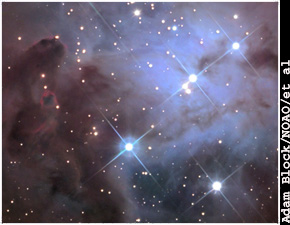Mars, the fourth planet from the sun, is roughly 142 million miles from
the sun.The planet's reddish color is caused by iron oxide in
the soil.
Mars has the largest canyon (Valles Marineris), and the highest volcano (Olympus Mons) in the solar
system. If Valles Marineris were on Earth, it would span the United States, from New York
on the East Coast to California on the West Coast. It is about 1,300 miles long, 310 miles wide, and about 5 miles deep. Olympus Mons is nearly 3 times higher than Mount Everest. It rises above the Martian surface more
than 82 thousand feet. This giant volcano's base is the size of Missouri.
Most scientists believe water once flowed on the martian surface,
but new studies suggest there may still be water in some places on the surface. Evidence of this can be seen by the many dry
river beds seen in many photos taken of Mars. However it is believed that most remaining water on Mars is locked in the polar
ice caps or as permafrost.
The lowest surface temperature on Mars is 190°F, while the hottest temperature
is 90°F.
The martian atmosphere is very thin and made of carbon dioxide (95%), nitrogen (3%), argon and other
gases (1%).
Mars has two potato-shaped moons, Phobos is about 17 miles long and Deimos
is about 9 miles long.
Because the Red Planet's color reminded ancient astronomers of blood, they
named the planet after their gods of war. Mars was the Roman god of war. The planet's two moons also have names that relate
to war. Phobos means fear, and Deimos means panic.

